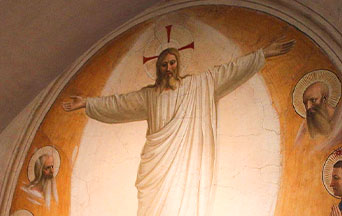
August 6 is the feast of the Transfiguration of Our Lord Jesus Christ. On this day, the first church on Mount Tabor was dedicated. Tradition has it that Mount Tabor was the “high mountain” described in the Gospel as the site of the Transfiguration.
In 1457, Pope Callistus III ordered this feast to be solemnly celebrated throughout Christendom in thanksgiving for the defeat of the Turks in Belgrade, especially due to the heroic efforts of Saint John of Capistrano. The novena to Our Lady of the Assumption also begins on this day.
We all know the Gospel episode in which the Lord goes up with Peter, James and John to the top of Mount Tabor. At a certain moment, He manifests Himself in all His glory with Moses on one side and Elias,1 our spiritual father, on the other.
The disciples are so enthralled with His glory that they express a desire to remain there. However, this external manifestation of glory gradually diminishes as the disciples see things more or less return to normal as they were before the Transfiguration. As Our Lord comes down from Mount Tabor, He reveals such an extraordinary majesty that people cry out in fear before Him.
We can make two considerations about this extraordinary event.
 Learn All About the Prophecies of Our Lady of Good Success About Our Times
Learn All About the Prophecies of Our Lady of Good Success About Our Times
The Transfiguration can help us imagine the majesty of Our Lord Jesus Christ. Artists that paint the Transfiguration usually do not present this imposing majesty. The scene often shows Christ with a very placid and serene countenance and the Apostles looking at Him with great admiration. Our Lord is indeed surrounded by great glory, but He Himself expresses placidity, serenity and affability. These qualities were undoubtedly present in the appearance of the transfigured Christ. This mode of representation is by no means false.
However, in the infinite richness of Our Lord’s holiness and Person, we can find a full spectrum of all the virtues taken to their final consequences. His most sublime perfection existed at the same time with His Divine affability. His majesty and superiority were such that they had no proportion to any human conception. Precisely this legitimate superiority instilled respect, affection and fear. This fear is properly speaking called the fear of the Lord.
Thus, in addition to affability, the face of Our Lord also represented sublimity, regal nobility, power, seriousness, gravity and strength, which explains why those who saw Him were left astounded and trembling with fear.
We could hope that some artists might also paint this aspect of Our Lord’s Transfiguration. This would help us understand the facts as they were. Such a portrayal would also erase the idea of Jesus Christ as one who limited Himself to expressing benevolent attitudes throughout His life.
These benevolent attitudes exist and are adorable and marvelous. They should enchant the soul. However, they must be understood in the full spectrum of harmonic yet opposite virtues. The practice of maximum and contrary virtues constitutes the perfection of holiness.
10 Razones Por las Cuales el “Matrimonio” Homosexual es Dañino y tiene que Ser Desaprobado
There probably is not a painter talented enough to portray both aspects of the Transfiguration simultaneously. Only a person of exceptional mind and talent could do this. One solution would be to have one artist paint one aspect while a different artist paints the other. Then we could put them together and have an ideal notion of this extraordinary episode.
Another consideration involves the disciples whom Our Lord called to Tabor. They were also the ones He wanted closest to Him in the Garden of Olives. It is fitting that those who witnessed His glory would also share most intimately in His sorrow. They required more faith in His Divinity when they witnessed the scandalous humiliations He endured in the Garden.
We might also apply this to our lives as Catholics. So often, Our Lady works truly marvelous things in our apostolate that fill souls with joy. Seeing this, someone might say: “You are so joyful. Good, be even more joyful! But ask for the grace to be faithful in times of sorrow!”
There may be a time when all these glories seem to disappear, and every humiliation falls upon us. There may be a time when all our hopes seem trampled underfoot. We might see Our Lady’s finger guiding a particular event toward success. When disaster strikes, remember well that She is a queen and the Seat of Wisdom. She never puts her finger on something in vain or without seeing it to the end! In the worst of times, remember the best and trust in Our Lady to help in the future.
We can benefit by remembering these considerations on the feast of the Transfiguration of Our Lord Jesus Christ.
The preceding article is taken from an informal lecture Professor Plinio Corrêa de Oliveira gave on August 6, 1965. It has been translated and adapted for publication without his revision.—Ed.
Photo Credit: Miguel Hermoso Cuesta – WIKIMEDIA COMMONS

